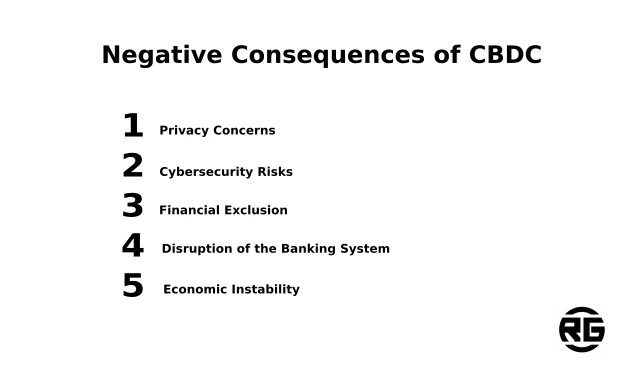The Rise of Bitcoin
Of course, the Bitcoin success leads to developing CBDC all around the world. The cryptocurrency’s value has skyrocketed over the years. Surely, a lot of them attracting attention from investors and regulators alike.
Due to its decentralized nature, Bitcoin don’t have any central authority. All of that, has led to concerns about its impact on the economy.
Without a doubt, some view Bitcoin as a disruptive force that can challenge the existing financial system. There are also those who claim that they will not work in the long run and are skeptical about them.
This article explores the concept of CBDCs (Central Bank Digital Currencies).
It will answer how they can potentially address the challenges posed by traditional cryptocurrencies.
Understanding CBDCs
A CBDC is a digital form of a country’s fiat currency, issued and backed by the central bank.
Unlike traditional cryptocurrencies like Bitcoin, CBDCs are centralized and controlled by a central authority.
The concept of CBDCs is not new. Several central banks have been exploring the possibility of issuing their digital currencies.
The People’s Bank of China is one of the first central banks to pilot a CBDC. It called the Digital Currency Electronic Payment (DCEP). The European Central Bank is also currently exploring the possibility of issuing a digital version of the euro.

In fact, CBDCs are central bank digital currencies for the general public. One of the assumptions of CBDC is to displace cash from circulation and generate digital money out of thin air. By the way, do any of you know that this is how central banks generate debt in the bank for the person taking the loan. That’s right, it is done without any other assets from the air.
How CBDCs Differ from Traditional Cryptocurrencies
One of the key differences between CBDCs and traditional cryptocurrencies is the level of centralization. Cryptocurrencies like Bitcoin are decentralized and operate on a peer-to-peer network.
There are CBDCs whose centralized and controlled by the central bank. This means that CBDCs are subject to regulation and oversight by the central bank.
They can be used as a tool for monetary policy. Another key difference is the level of anonymity. Cryptocurrencies like Bitcoin are pseudonymous, which means that users can transact without revealing their identities.
CBDCs, on the other hand, are likely to be fully traceable. It can help prevent money laundering and other illicit activities. Don’t be fooled at all. There are a lot of disadvantages of using CBDCs?
Pros and Cons of Using CBDCs
The rise of digital currencies has led to a lot of debate among economists, policymakers, and investors. On the one hand, digital currencies offer several advantages over traditional currencies.
For example, digital currencies can be used for instant and low-cost transactions across borders. That can boost economic activity and financial inclusion.
Digital currencies can also reduce the need for intermediaries like banks, which can lower transaction costs and increase efficiency.

To be objective, it should also be added that CBDCs may have some good sides. Such as low transaction costs and eliminating intermediaries in the transaction. All this convenience also has negative consequences for society.

However, digital currencies also pose several risks, such as the potential for cyber attacks, volatility, and the lack of regulation. Additionally, the adoption of digital currencies can pose challenges for monetary policy. As a consquence, central banks would need to find new ways to control the money supply.
Negative Consequences of CBDC
CBDC (Central Bank Digital Currency) is a digital form of currency. They are issued and regulated by the central bank of a country. While CBDC has several potential benefits, there are also negative consequences that can arise from its use. Some of the negative consequences of using CBDC include:
Privacy Concerns
CBDC transactions can be traced and monitored by the central bank, which raises concerns about individual privacy. The central bank would have access to information on every transaction made using CBDC. It could be a cause for concern for people who value their privacy.
Cybersecurity Risks
Digital currencies are vulnerable to cyber attacks. The implementation of CBDC could increase the risk of hacking, fraud, and other cyber threats. This could lead to financial losses for both individuals and the central bank.
Financial Exclusion
Not everyone has access to digital technology. It could create a digital divide and exclude people who don’t have the means or ability to use CBDC. This could have a significant impact on low-income households, older people, and people living in remote areas.
Disruption to the Banking System
CBDC could disrupt the traditional banking system by reducing the demand for bank deposits. Potentially making it easier for people to bypass banks altogether. This could have negative consequences for the banking sector and could lead to financial instability.
Economic Instability
The introduction of CBDC could have significant implications for monetary policy, potentially leading to increased volatility in the financial system. The central bank would have to carefully manage the supply and demand for CBDC. They need ensure that it doesn’t destabilize the economy. It leads to more control of people.
While CBDC has the potential to offer several benefits. It is important to carefully consider the potential negative consequences.

It can undoubtedly be seen that CBDC means less privacy and more control over society. The rulers themselves will have another tool in their hands to financially exclude people who present a narrative that is inconsistent with the one imposed by the governments. All this means that the world is moving in a direction that is nothing short of limiting freedom of speech and conduct.
Potential Impact of CBDCs
The adoption of digital currencies can have a significant impact on the global economic landscape. For one, digital currencies can make cross-border transactions faster, cheaper, and more accessible.
This can boost trade and investment, leading to increased economic growth. Digital currencies can also increase financial inclusion, especially in developing economies where access to traditional financial services is limited.
However, the widespread adoption of digital currencies can also disrupt the existing financial system. That leading to job losses and the displacement of traditional financial institutions.
The Future of CBDC
The future of digital currencies is still uncertain. There are many challenges that need to be addressed before they can become mainstream.
One of the biggest challenges is regulation. Digital currencies operate in a regulatory gray area. There is a lack of consensus among policymakers about how to regulate them.
Additionally, the adoption of digital currencies can pose challenges for monetary policy. Central banks would need to find new ways to control the money supply.
However, there are also many opportunities. Digital currencies can increase financial inclusion, boost economic growth, and reduce the need for intermediaries like banks.
Adoption of CBDC
The adoption of digital currencies varies across the world. In some countries, like China, digital currencies are already being piloted. While in others, like the United States, there is still a lot of debate about their potential impact.
Developing economies, in particular, are likely to benefit from the adoption of digital currencies. They can increase financial inclusion and reduce the cost of transactions.
However, there are also concerns about the potential for digital currencies to be used for illicit activities. Activities such as money laundering and terrorism financing.

Testing CBDC on the world is on advanced levels. In fact, in USA, India and China running pilot programms. In addition to that, in many countries on the world there are proof of concept or researches. Generally to say, there is great interest in the introduction of CBDC. Which really shouldn’t be surprising, because CBDC means greater control for those in power. Finally, it should be added that Nigeria already has its e-Naira and it is being tested among the public.
Regulation of CBDCs
The regulation of digital currencies is a complex issue. There is a lack of consensus among policymakers about how to regulate them. Some countries, like Japan and Switzerland, have taken a proactive approach to regulating digital currencies.
While others, like the United States, have been more cautious.
One of the biggest challenges in regulating digital currencies is striking a balance. It all about balance between protecting consumers and preventing illicit activities. Beside that, allowing for innovation and growth in the industry.
Conclusion
Digital currencies, and in particular CBDCs, have the potential to reshape the global economic landscape. While digital currencies offer several advantages over traditional currencies, there are also many challenges that need to be addressed.
Cryptocurrencies become mainstream some day, but CBDCs are also waiting. Regulators and policymakers will need to find a way to strike a balance between protecting consumers and preventing illicit activities.
There need to be still allowing for innovation and growth in the industry. The adoption of digital currencies is still in its early stages like adoption of CBDCs.
It will be interesting to see how crypto evolve in the coming years. In case of CBDCs are many dangers for private users – lack of privacy and freedom and more control by government.
Bitcoin was invented by people whose believe in freedom at first. At least we want to believe in that.

Leave a Reply
You must be logged in to post a comment.